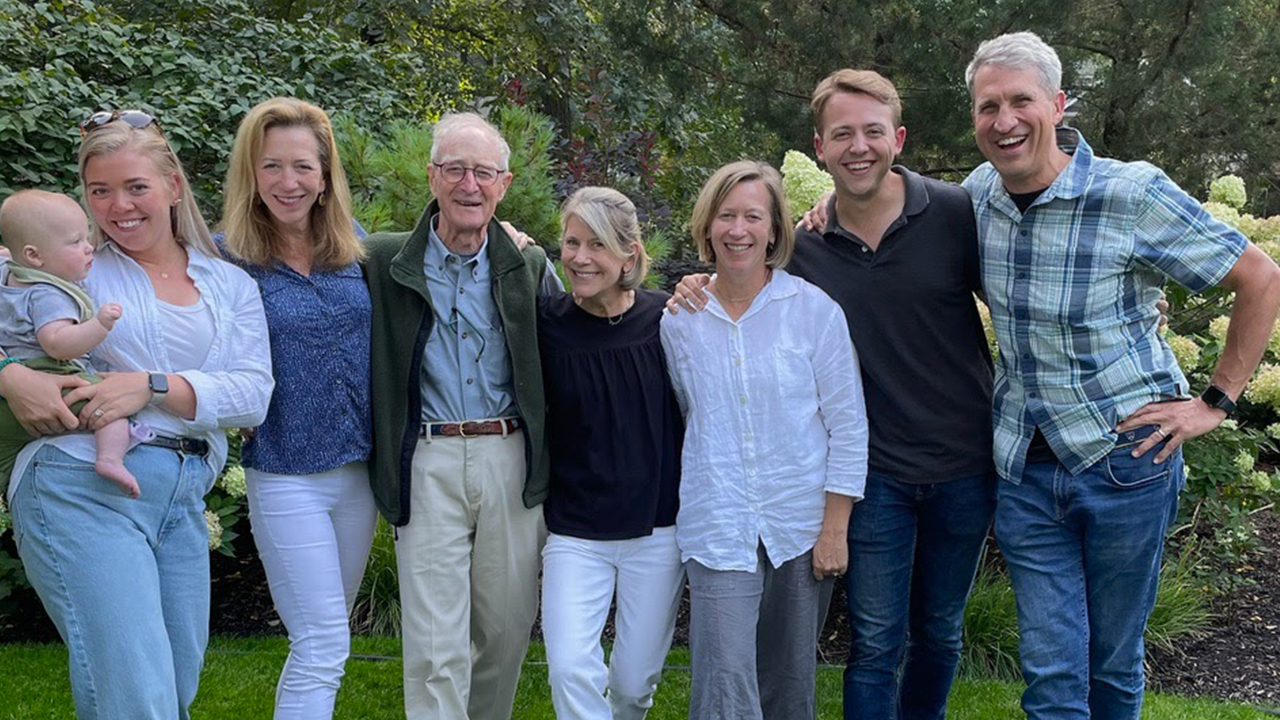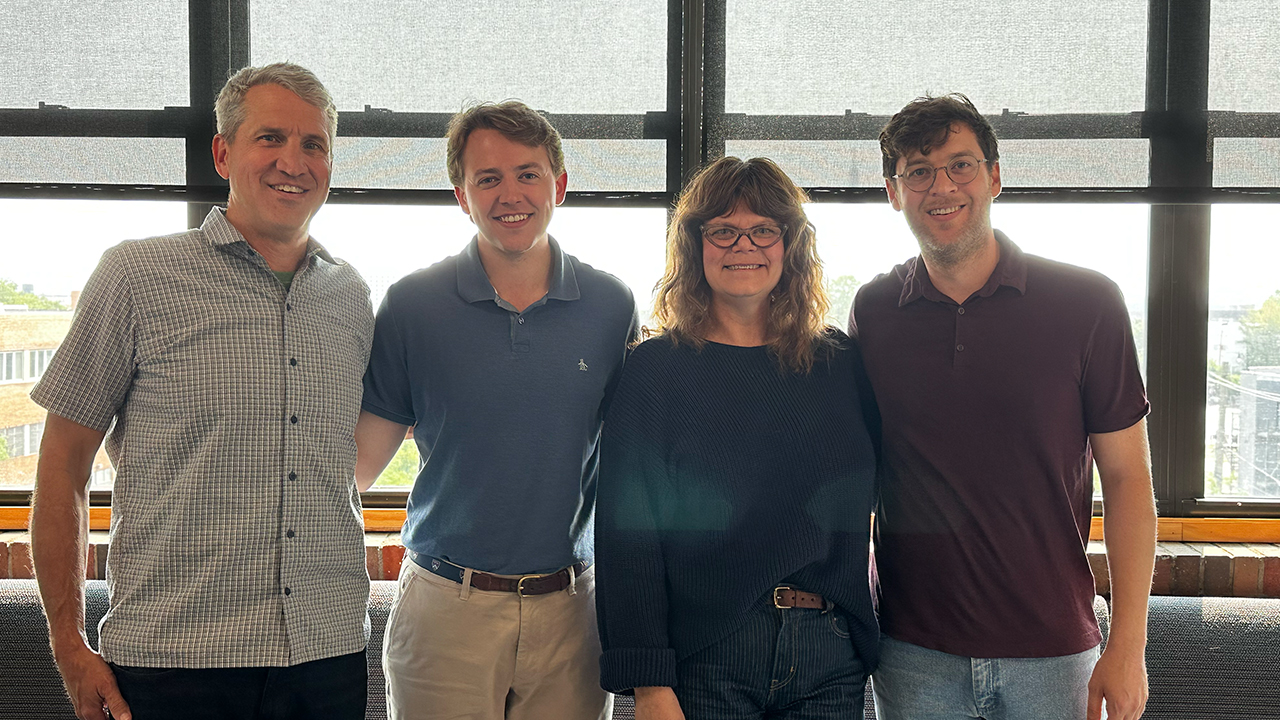The evolution of Channeled Resources Group
The family-owned business has expanded beyond its initial role as a recycling company, but sustainability still forms a key part of its ethos.

The Frost family, L-R: Ginnie Gandy with baby Emmett, Cindy Frost White, Calvin Frost, Debbie Shepherd, Sarah Hoffman, Alex Hoffman and Rich Hoffman
In 1978, Calvin Frost founded Channeled Resources Group (CRG) as a traditional paper recycling company, buying wastepaper and selling it to paper mills. Over the decades, the company’s mission changed, as it persevered through challenges and seized new opportunities.
CRG is no longer a paper recycling company. Instead, it operates in three primary markets, selling pressure-sensitive roll labelstock, blank labels and release liners.
Frost is also no longer the CEO of CRG. He has taken a step back and is now chairman, while his eldest daughter, Cindy White, serves as president and CEO, a role she assumed in 2007. Frost’s younger daughters, Sarah Frost Hoffman and Debbie Frost Shepherd, also work at CRG, serving as the label division coordinator and office manager, respectively. Ownership of the company is split evenly between Frost’s three daughters. Rich Hoffman, Sarah Frost Hoffman’s husband, is the COO.
Over the past few years, the third generation of the family has become more involved with the company. White’s daughter, Ginnie Gandy, is the sales manager for the release liner division, and Hoffman’s son, Alex Hoffman, is the market manager in the label and PS division.
CRG’s release liners are the fastest-growing segment of the
company, making up approximately 45 percent of the business. Blank labels make up about 35 percent. The labelstock, which CRG produces from offcuts acquired from major manufacturers, accounts for about 20 percent of the business. CRG’s label and PS customers are primarily converters, with some packaging companies as well. The release liner business sells to tape, medical, industrial and other applications.
‘Though we’ve moved away from recycling, sustainability is
still a core part of who we are, and it drives a lot of things that we do, whether it’s finding an alternative solution to polycoated craft material like BCK, or getting FSC-certified material for customers,’ Alex Hoffman says. ‘Even though we’ve transcended our origins in recycling and sustainable solutions, we still offer them to customers.’
CRG is headquartered in Chicago, with facilities in Marathon
City, Wisconsin, Indianapolis and Toronto. The company has grown from its modest beginnings to now employing more than 160 people. CRG has a goal of becoming a 125m USD company in the next several years.
Changing mission
CRG began expanding beyond its original mission in the 1980s. Interest rates had surged, reaching a peak of 19-20 percent, and the wastepaper industry at the time was also a volatile one.
That motivated Frost to steer the company into recycling
nonrecyclable materials, specifically, coated and treated laminated paper, which is difficult for paper mills to process.
‘That transition in the early ‘80s, from getting out of the
recycling of recyclables and into the recycling of nonrecyclables, was critical to the success of Channeled Resources,’ Frost says.
That transition began with a partnership with a facility in Iowa City, Iowa, where Frost discovered some rolls of material that had been discarded behind the plant. Despite not knowing what those rolls were made of, Frost offered to take them away.
“We must have saved millions of tons of material from going to the landfill in the years that we’ve been doing this”
Over the next six months, CRG collected hundreds of tons of
material from this plant, eventually learning that they were release papers with a polyethylene coating and silicone on top. CRG was able to find a market to resell this material, both domestically and internationally. Soon, CRG began diverting other companies’ coated substrates, primarily pressure-sensitive label materials, away from landfills and selling them.
White joined the company in 1987. At the time, there were just three employees: White, Frost and a secretary.
‘We must have saved millions of tons of material from going to the landfill in the years that we’ve been doing this,’ White says. ‘Before we did it, all pressure-sensitive waste went to the landfill, and now very little of it does.’
In the early 1990s, the company started producing silicone-coated release liners.
Around 1990, CRG also began diverting its waste from landfills by partnering with other companies to convert it into fuel. This has proven to be an effective avenue to repurpose matrix waste. CRG has changed partners for this over the years, but since the mid-2000s, the company has consistently been a supplier to Convergen Energy in Green Bay, Wisconsin. This partnership allows CRG to achieve a 96 percent landfill-free status.
‘That hasn’t changed and will never change,’ Rick Hoffman says of this side of the business. ‘That’s our commitment to the market and the industry.’
CRG expanded into blank labels because of interest from converter customers.
‘A lot of our customers for blanks are also our pressure sensitive customers who don’t want to waste press time making things that don’t add value,’ White says. ‘So, they get their blanks from us, and they do all their high-quality, high color print with their own machines.’

Technology
Today, for the PS segment of the company, CRG acquires off-cuts and seconds from major PS manufacturers, which CRG slits and rewinds to each customer’s requirements. These rolls are upcycled for customers at reduced prices. Most of this material is paper, though film makes up a significant and growing percentage. This area of the business is particularly valuable for smaller converter customers, who may be more price-sensitive and benefit from smaller rolls.
‘It helps so many converters that want to buy a small quantity,’ says Marie Casillas, sales manager for PS.
To upcycle this material, CRG has 13 slitter-rewinders from various suppliers: Stanford, Elite Cameron, Catbridge and Kampf.
‘Every slitter is different to do the different types of materials that we’re slitting and rewinding,’ White says. ‘We can slit narrow widths with the small Stanfords, to wide widths with our Catbridges and Kampfs.’
For its blank labels, CRG manufactures the entire end product. The company silicone-coats the release liner, applies the adhesive coating, laminates the product, then converts and finishes the labelstock into rolls. CRG produces its large blank label jobs on ETI Converting machinery and the smaller, custom jobs on die-cutters.
‘We’ve gotten into different substrates when it comes to the blank label side,’ says Nick Negulescu, CRG’s business development manager. ‘Traditionally, it was just direct thermal and thermal transfer paper. We’ve added synthetics to that portfolio as well, such as a more durable film and base stock that’s thermal transfer printable or direct thermal printable. We’ve also expanded into inkjet-printable labels for those markets that require them.
‘That’s the cool thing about our label process,’ he adds. ‘Since we’re manufacturing the substrate ourselves, if a customer comes to us and says, “Hey, I need this kind of particular substrate or something similar to it”, we have the relationships to be able to go out and source that material, to put it into our process, to be able to produce that for them as a finished product at the end of the day.’
CRG’s newest piece of equipment is a Domino printbar. This machine attaches to a die-cutter and prints marks on the backs of labels.
‘We had a lot of customers who wanted this, to do numbering of labels, just tick marks on the back of a label,’ White says of the Domino machine. ‘We kept getting the inquiries, so it was just handling a need that we were being asked about.’
CRG produces its release liners using four silicone coaters at its facilities in Toronto and Marathon City. One of CRG’s most significant and recent investments has been a 70in wide coater from SAM North America, capable of running up to 1,500 ft/min.
New initiatives
In the spring, CRG launched a new website. This site is designed to be more intuitive and provide a simpler user experience.
For the first time, the website allows users to view CRG’s PS inventory. Because the products in this inventory are obtained as offcuts from various manufacturers, they are constantly changing. Customers can now use the website to learn what is in stock.
In 2024, CRG also became the first sponsor of TLMI’s Liner Recycling Initiative.
“It’s a big team, and it’s a wonderful environment to work in”
CRG had previously attempted to start a liner recycling program by collecting spent release liners from end users, repulping them, and reselling the pulp. CRG also sold the used liner to China, where it was repurposed. However, collecting the spent release liner was challenging and expensive, and the program didn’t last.
Rich Hoffman hopes that the market is more ready for such an initiative now.
‘Calvin is a pioneer,’ Rich Hoffman says. ‘He’s the first one who started pushing for liner recycling and who pushed the industry toward that.’
Industry challenges
Like most manufacturers, CRG has faced workforce challenges. In Marathon County, Wisconsin, where CRG has a facility, the unemployment rate is under 3 percent, underscoring this difficulty.
CRG has invested in automation to ease that challenge, such as in its tapers, unwinders, turrets and more. The company offers bonuses for employee referrals and provides cross-training for staff.
Moreover, CRG faced challenges with tariffs, pricing pressure, and an influx of low-cost imports from China. The company’s supplier relationships, as well as its continued emphasis on quality, flexibility and value as differentiators, have helped CRG navigate these challenges.
A family business
Frost started CRG in the 1970s because he no longer wanted to work in a corporate environment. Today, CRG remains a family-owned business where everyone knows each other.
‘You’re not a number; you’re a person,’ says Casillas, who isn’t related to Frost, but says she feels like part of the family. ‘You can go right to the president. You can go right to the COO and ask questions. We all work together as a team from the top all the way down. It’s a big team, and it’s a wonderful environment to work in.’
White says: ‘We have 160 employees, and I know every one of them, which is fun. It’s a big responsibility, though.’
As chairman, Frost remains a part of the company. He regularly visits the office and is heavily involved in the waste energy side of the company, as well as its international business.
‘I’m older now, and I don’t have the same energy level, and I don’t think the same way as everybody else does, and I understand that,’ Frost reflects. ‘I think you have to be willing to give up, and I think I’ve done a reasonably good job at that. No ego in that regard. Cindy and Rich found a little corner for me to stay active, which I love.’
Stay up to date
Subscribe to the free Label News newsletter and receive the latest content every week. We'll never share your email address.


